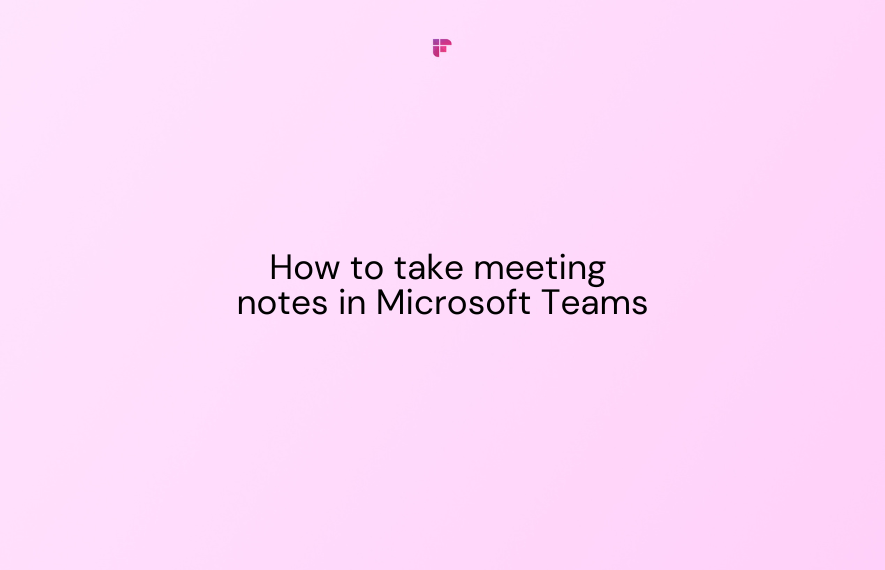Meeting culture can make or break the productivity and morale of a team. While meetings can be a powerful tool for collaboration and decision-making, they can also become a dreaded and time-consuming obligation.
Turn those frustrating sessions into productive, collaborative, and efficient gatherings—no more pointless arguments or time-wasting tangents. Just focused meetings that get things done with a better meeting culture.
Read on as we share some tips on how to improve meeting culture.
What is meeting culture?
Meeting culture refers to the attitude, values, and behavior that shape how organizations conduct meetings.
It combines things like:
- How people communicate
- The decision-making process
- Having collaborative discussions
- Achieving meeting objectives
A positive meeting culture fosters inclusivity, accountability, and innovation among team members. In contrast, a negative culture can lead to misunderstandings, conflicts, and disengagement among participants.
Why is meeting culture important?
Time—the one asset none of us are ever going to get more of.
– Gary Vaynerchuk
According to a survey of senior managers, 71% admitted that their meetings are unproductive, and 65% said meetings take so much time that they can’t finish their work.
A healthy meeting culture gives back your time. When meetings are well-planned, well-organized, and well-executed, they can help to:
Improve communication: Meetings allow team members to share information, ideas, and feedback, leading to better communication and understanding.
Foster collaboration: Meetings encourage cooperation and teamwork, allowing team members to work together towards common goals and objectives.
Make informed decisions: Meetings facilitate decision-making by providing a forum for discussing options, analyzing data, and considering various perspectives.
Boost morale: A positive meeting culture can boost team morale by creating a sense of inclusivity, appreciation, and engagement.
Therefore, better meeting culture directly translates to satisfied and better-engaged employees. It invokes a sense of belonging to the workplace.
3 signs of a bad meeting culture
Here are three signs to determine if you work in a company with a terrible meeting culture.
Meetings happen without a clear agenda
Have you ever been in meetings where the conversations go in circles? It’s most likely because the discussions were happening without an agenda.
A meeting agenda gives your meeting the direction it needs. It lets participants know what to expect and how to prepare, making it easier to steer the discussion toward productive outcomes.
Besides, a positive meeting culture prioritizes preparation and organization.
Poor communication
Poor communication during meetings is a clear indication of bad meeting culture and can take many forms:
- People talking over one another
- Not interested in listening to conflicting opinions
- Unwillingness to find common ground
- Constantly talking about whose ‘fault’ it was
- Not knowing what to do next after the meeting ends
This results in trust issues and a lack of respect for teammates. It might cause some people to stop contributing their thoughts entirely.
Meetings don’t stick to the schedule
No one appreciates meetings overstaying their welcome.
Imagine you have a pile of work to go through, a deadline looming, and a meeting that seems to be going on forever. You're trying to pay attention, but all you can think about is the clock ticking away and the other things you need to get done.
When a meeting takes longer, it disturbs the entire schedule of the employee. Meetings are important, but so is work.
3 signs of a great meeting culture
Open and inclusive communication
Employees feel their opinions matter if the meeting encourages them to speak freely and contribute to the discussion.
Even if there is a conflict, you sit, talk, and find a solution without disrespecting anyone. That’s what a fantastic meeting culture is.
When people feel like they're part of the team, they're more engaged and invested in the outcome of the meeting.
Sticking to the meeting agenda
Every meeting needs a purpose to be relevant. It’s why people invest their time in it.
A meeting agenda acts as a roadmap of all the topics to be covered. It ensures you don’t miss anything important.
By fostering a solid meeting culture, companies can demonstrate that they value their employees' time and prioritize efficiency.
Accountability of action items
With clearly defined action items, everyone is accountable for their responsibilities.
The team knows what they need to do and by when, which helps avoid confusion and prevents delays. That’s the sign of a productive meeting.
It also makes it easy for the team to measure the progress and seek help with their tasks if needed.
6 tips to improve meeting culture
By now, you must know what kind of meeting culture you’re dealing with currently. If it’s good, it can still be better.
Here are six tips to help you improve:
- Make your meetings inclusive
- Avoid unnecessary meetings and attendance
- Respect the meeting duration
- Use technology
- Delegate meeting roles
- Evaluate for areas of improvement
1. Make your meetings inclusive
Inclusive meetings are an essential factor in fostering an inclusive workspace. They have no bystanders.
Start by creating a meeting environment where everyone feels valued and included. People are allowed to bring their diverse views to the table.
Encourage participation and make sure everyone has a chance to speak up. And if someone seems hesitant, try to draw them out by asking open-ended questions.
2. Avoid unnecessary meetings and attendance
Having meetings is necessary, but you should also know when to avoid them.
Ask yourself, is there a quicker way to share this information? Would a message, phone call, or email suffice? If yes, save some time because the meeting isn’t needed.
Use asynchronous meetings to save time and get things done. It’s important because:
- No one wants to attend meetings that could have been an email.
- Canceling unnecessary meetings can make people feel their time is respected.
- It will give your team more time to focus on the task at hand.
Additionally, you can make it optional for people to join the meeting. Allowing people to opt out can ensure that only those who have a stake in the outcome of the meeting will be present.
It also gives some people more time to focus on their tasks and responsibilities.
3. Respect the meeting duration
If the meeting is supposed to run for 60 minutes, stick to it. It’s ok if you wrap things a little early, but it’s rarely ok to exceed it.
If you have multiple agenda items to discuss, allocate time to each one accordingly.
You expect people to join the meeting on time. But punctuality is a two-way street—if they show up on time, ensure they leave on/before time.
4. Introduce technology
Technology has changed the way we work and communicate. It can also significantly impact the meeting culture of your workplace. You can leverage technology to make your meetings more efficient in multiple ways.
For example, you can use async tools like Slack or Loom to share your ideas or thoughts. Alternatively, tools like Fireflies AI notetaker can help you record, transcribe, summarize, and analyze online meetings so you can be present in the conversations.
Even if you miss the meeting or are an optional attendee, Fireflies will send you the meeting recaps so you can review the meetings in minutes.
Search the meeting transcript using system-generated AI filters, topic tracker, or the transcription search bar, or use the ChatGPT for meetings feature, AskFred, to know what happened during the meeting.

5. Delegate meeting roles
Delegating meeting roles can greatly improve engagement among meeting participants. Think of it like a team sport— everyone has a part to play and a job to do.
These roles can be:
- A facilitator who schedules, organizes, and runs the meetings.
- A gatekeeper who oversees how people speak. Their job is not to let any one person dominate the conversation.
- A timekeeper keeps track of the time, so the meeting starts and ends on time.
- A note-taker manually takes notes throughout the meeting, outlining all the action items and important information. Later they share it with the entire team.
Try Fireflies for free!
- A presenter who presents information and insights during meetings. Like reports, data, presentations, etc. They also need to be prepared for follow-up questions.
These roles are to give you an idea. You can delegate new roles according to your requirement. Keep shuffling the responsibility, so one person doesn’t end up doing the same thing.
6. Evaluate meetings for areas of improvement
The journey to an enhanced meeting culture starts with self-assessment.
After each meeting, get feedback from your team members to see what went well and what could be improved. After all, they're in the trenches, so they'll have valuable insights.
By regularly evaluating your meetings, you can identify areas for improvement and work to create a more productive and efficient meeting culture. Plus, asking for feedback shows your team that you value their input and are committed to building a positive working environment.
Here are a few questions to help you get started:
- Was the meeting agenda clear and easy to follow?
- Was everyone able to participate and share their opinions?
- Was the meeting length appropriate or too long/short?
- Were the action items clearly defined and assigned?
- Was the meeting technology working smoothly?
- Did the meeting achieve its desired outcomes and objectives?
Wrapping up
We hope to have answered your question, “How to improve meeting culture?”
By implementing some of the tips we have discussed, such as setting clear objectives, establishing ground rules, and leveraging technology, you can create an environment where everyone feels valued and heard.
Encouraging active participation, promoting diversity and inclusion, and respecting everyone's time will go a long way in making your meetings more effective and enjoyable.
While you are at it, remember, a healthy meeting culture doesn't happen overnight. It requires patience, dedication, and an unwavering commitment to improving constantly.
So, invest the time and effort to improve your meeting culture, and you will see the benefits in all areas of your organization.







